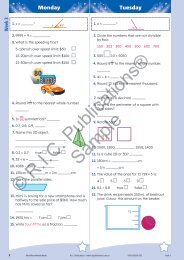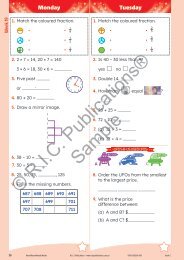RIC-20234 Primary Grammar and Word Study Year 3 – Parts of Speech
You also want an ePaper? Increase the reach of your titles
YUMPU automatically turns print PDFs into web optimized ePapers that Google loves.
<strong>Parts</strong> <strong>of</strong> speech<br />
Prepositions<br />
Focus<br />
Prepositions: movement, direction, time <strong>and</strong> place<br />
Definition<br />
• Prepositions are words used to show the relationship<br />
between nouns <strong>and</strong>/or pronouns in the same sentence.<br />
Example:<br />
The steam engine powered through the dark tunnel.<br />
Explanation<br />
• The word ‘preposition’ combines the prefix ‘pre’ (meaning<br />
‘before’ or ‘in front <strong>of</strong>’) <strong>and</strong> the word ‘position’. This<br />
indicates the nature <strong>of</strong> prepositions, as words that are<br />
‘positioned in front’ <strong>of</strong> nouns or other words that function<br />
as nouns (such as pronouns or noun phrases).<br />
• Prepositions indicate a connection between things<br />
mentioned in a sentence, such as between a person <strong>and</strong><br />
where she/he is going.<br />
Example:<br />
Jill moved towards the table.<br />
Prepositions can refer to manner (he came by bus), time<br />
(school starts at 9 am), place (he left his shoes at the park),<br />
position (the cat lay under the table) <strong>and</strong> direction (it ran<br />
between the buildings).<br />
Some prepositions are formed by combining words, such<br />
as the phrases in front <strong>of</strong>, on top <strong>of</strong> <strong>and</strong> prior to.<br />
• Prepositions are <strong>of</strong>ten used to introduce phrases that<br />
add more information to the noun or verb <strong>and</strong> are called<br />
prepositional phrases. These phrases start with a<br />
preposition <strong>and</strong> end with a noun or noun equivalent, called<br />
the ‘object’ <strong>of</strong> the preposition. <strong>Word</strong>s that modify the object<br />
are part <strong>of</strong> the phrase.<br />
Example:<br />
The little girl (subject) was shorter than (preposition)<br />
her younger brother (object). (The prepositional<br />
phrase is underlined.)<br />
• As a rule, prepositions do not come before verbs.<br />
• A former rule with prepositions was that they should never<br />
end a sentence. This rule no longer applies. For example,<br />
It is commonly accepted as correct to say ‘Have you found<br />
the shoes you were looking for?’ rather than the Old English,<br />
‘Have you found the shoes for which you were looking?’<br />
• Prepositions add meaning <strong>and</strong> information. They also help<br />
to distinguish between the object <strong>and</strong> the subject in a<br />
sentence. Commonly used prepositions include:<br />
about, above, across, after, against, around, at, before,<br />
behind, beneath, beside, between, beyond, by, for, from,<br />
in, inside, near, <strong>of</strong>f, on, out, over, through, to, toward,<br />
under, until, upon <strong>and</strong> with<br />
Bear in mind that these words are not always prepositions;<br />
sometimes they function as conjunctions or adverbs.<br />
For example, in the sentence ‘Mia decided to stay inside’,<br />
‘inside’ has no object <strong>and</strong> so is an adverb.<br />
Worksheet information<br />
• Although prepositions can refer to things other than<br />
position, the focus at this level remains on position <strong>and</strong><br />
location. As an introduction, perhaps place a number <strong>of</strong><br />
students in front <strong>of</strong> the class <strong>and</strong> discuss their positions<br />
in relation to each other; e.g. Sarah is between Jacob <strong>and</strong><br />
Mara, Poppy is in front <strong>of</strong> Ben <strong>and</strong> behind Kiera. Focus on<br />
the prepositions linking two nouns.<br />
• Give each student a copy <strong>of</strong> the worksheet <strong>and</strong> read<br />
the introductory text. Ask the students to identify some<br />
prepositions. Students then complete Question 1 by circling<br />
the prepositions. They can draw a scene for the front <strong>of</strong><br />
the postcard based on the description. To complete the<br />
worksheet, students write a description <strong>of</strong> a place they<br />
have been to on holiday, using as many prepositions as<br />
they can.<br />
Ideas for further practice<br />
©R.I.C. Publications<br />
Low Resolution Images<br />
Display Copy<br />
• Give students an outline <strong>of</strong> a house. Instruct them to draw<br />
something in, on, above, below, next to etc. the house.<br />
Students share <strong>and</strong> describe their pictures with others in<br />
the class.<br />
• Students can choose one preposition <strong>and</strong> a specified<br />
person or animal <strong>and</strong> draw an illustration showing both.<br />
These can be compiled as a class book.<br />
Answers<br />
1. Prepositions: at, up, between, with, On, behind, near, to,<br />
<strong>of</strong>, Below, down, with<br />
2.<strong>–</strong>3. Teacher check<br />
<strong>Primary</strong> grammar <strong>and</strong> word study 32<br />
www.ricpublications.com.au R.I.C. Publications ®


















